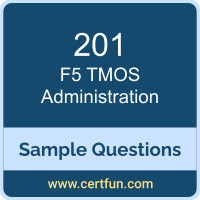01. Listeners that correspond to non-floating self lP addresses are stored in which configuration file?
a) /config/bigip.conf
b) /config/bigip_base.conf
c) /config/gtm/wideip.conf
d) /config/bigip_local.conf
02. Which statement is true regarding OneConnect processing?
a) Client-side request can utilized existing server-side connections.
b) Server-side request can utilize existing client-sid connections.
c) The number of client connection is reduced.
d) The virtual server must have UDP profile.
03. A BIG-IP Administrator makes a configuration change to a Virtual Server on the Standby device of an HA pair. The HA pair is currently configured with Auto-Sync Enabled.
What effect will the change have on the HA pair configuration?
a) The change will be propagated next time a configuration change is made on the Active device.
b) The change will be undone next time a configuration change is made on the Active device.
c) The change will take effect when Auto-Sync propagates the config to the HA pair.
d) The change will be undone when Auto-Sync propagates the config to the HA pair.
04. When initially configuring the BIG-IP system using the config utility, which two parameters can be set?
(Choose two.)
a) the netmask of the SCCP
b) the IP address of the SCCP
c) the port lockdown settings for the SCCP
d) the netmask of the host via the management port
e) the IP address of the host via the management port
f) the port lockdown settings for the host via the management port
05. A site has assigned the ICMP monitor to all nodes and a custom monitor, based on the HTTP template, to a pool of web servers. The HTTP based monitor is working in all cases. The ICMP monitor is failing for 2 of the pool member 5 nodes.
All other settings are default. What is the status of the monitor is working in all cases?
a) All pool members are up since the HTTPbased monitor is successful.
b) All pool members are down since the ICMPbased monitor is failing in some cases.
c) The pool members whose nodes are failing the ICMPbased monitor will be marked disabled.
d) The pool members whose nodes are failing the ICMPbased monitor will be marked unavailable.
06. What feature allows the F5 BIG-IP to choose another pool member and rebind the client connection to a new server when target pool member becomes unavailable?
a) Persistence Profile
b) Priority Groups
c) Action on Service Down
d) Slow Ramp Time
07. By default, how frequently are log files rotated?
a) hourly
b) daily
c) weekly
d) There is no default; the administrator sets the frequency.
08. Some users who connect to a busy Virtual Server have connections reset by the BIG-IP system. Pool member resources are NOT a factor in this behavior. What is a possible cause for this behavior?
a) The Connection Rate Limit is set too high
b) The server SSL Profile has NOT been reconfigured.
c) The Connection Limit is set too low.
d) The Rewrite Profile has NOT been configured.
09. How is MAC masquerading configured?
a) Specify the desired MAC address for each VLAN for which you want this feature enabled.
b) Specify the desired MAC address for each selfIP address for which you want this feature enabled.
c) Specify the desired MAC address for each VLAN on the active system and synchronize the systems.
d) Specify the desired MAC address for each floating selfIP address for which you want this feature enabled.
10. One of the two members of a device group has been decommissioned. The BIG-IP Administrator tries to delete the device group, but is unsuccessful. Prior to removing the device group, which action should be performed?
a) Make sure all members of the device group are in sync
b) Remove all members from the device group
c) Remove the decommissioned device from the device group
d) Disable the device group
 Getting knowledge of the F5 201 exam structure and question format is vital in preparing for the F5 TMOS Administration certification exam. Our F5 TMOS Administration sample questions offer you information regarding the question types and level of difficulty you will face in the real exam. The benefit of using these F5 201 sample questions is that you will get to check your preparation level or enhance your knowledge by learning the unknown questions. You will also get a clear idea of the exam environment and exam pattern you will face in the actual exam with the F5 TMOS Administration Sample Practice Test. Therefore, solve the F5 BIG-IP sample questions to stay one step forward in grabbing the F5 Certified Administrator - BIG IP (F5-CA) credential.
Getting knowledge of the F5 201 exam structure and question format is vital in preparing for the F5 TMOS Administration certification exam. Our F5 TMOS Administration sample questions offer you information regarding the question types and level of difficulty you will face in the real exam. The benefit of using these F5 201 sample questions is that you will get to check your preparation level or enhance your knowledge by learning the unknown questions. You will also get a clear idea of the exam environment and exam pattern you will face in the actual exam with the F5 TMOS Administration Sample Practice Test. Therefore, solve the F5 BIG-IP sample questions to stay one step forward in grabbing the F5 Certified Administrator - BIG IP (F5-CA) credential.